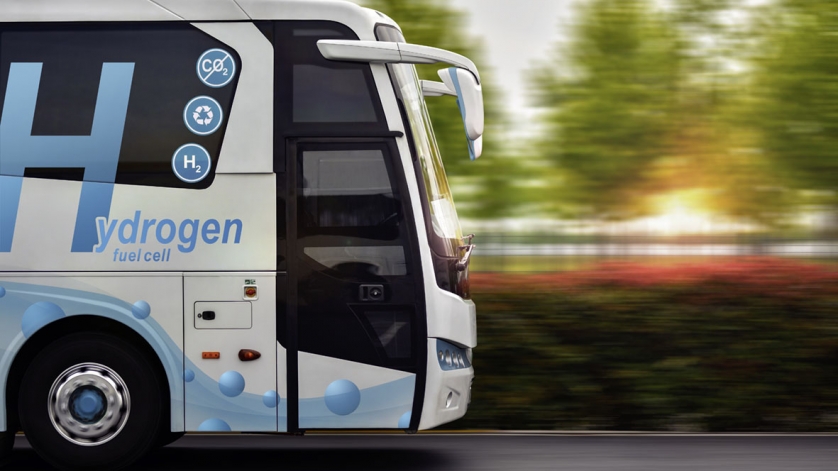
For powering on-road and off-road electric vehicles, hydrogen fuel cells hold key advantages over batteries. To ensure the safety of these vehicles, governments and standardising bodies around the world continue to establish and update guidelines, codes and regulations for hydrogen mobility and H2 fuelling stations.
Comparing battery-operated with hydrogen-powered vehicles
Although there are several technological alternatives to the traditional combustion engine today, battery electric vehicles (BEVs) are often the dominant solution in the public perception. This is especially true when considering passenger cars. E-car buyers have an increasingly wide choice of available models and the network of public charging stations is growing steadily.
However, there are two major downsides to battery drive systems:
- The majority of battery-powered vehicles still provide only a limited travelling range per charge
- The charging times for the batteries are significantly longer compared to a conventional refuelling process for combustion engines
Hydrogen fuel cells: The future of electric mobility
The more complex alternative is electric motors powered by hydrogen fuel cells. Fuel cell electric vehicles (FCEVs) are equal to vehicles with combustion engines in terms of performance and operating parameters – these include range, refilling time, cold resistance – but they operate CO2-free locally. These attributes are currently driving their growing popularity, especially for big vehicles like municipal vehicles, buses or trucks. Also in mobile working machines an increasing number of development projects are ongoing. Thousands of hydrogen-powered forklifts are already in use in warehouses and production halls. They emit only water vapour and no carbon monoxide or other harmful emissions. Since hydrogen-powered vehicles do not need to be refuelled for hours, they can be used more efficiently than battery-powered models.
Hydrogen mobility on the rise worldwide
Therefore, in 2022, some of the world’s largest economies are turning to hydrogen fuel cells and hydrogen vehicles to reduce and, in the long term, completely eliminate their carbon emissions. Below are therefore some examples of recent decarbonisation initiatives from around the world:
- Japan is pushing hard for a hydrogen-based society. The country already developed its basic hydrogen strategy in 2017. The Toyota Mirai, for example, was the world’s first commercially available FCEV. Moreover, the hydrogen refuelling stations network in Japan is currently the biggest globally with more than 130 stations in operation.
- Germany’s national hydrogen strategy has a 38-measure action plan that the country and the European Union will take by the end of 2023. The Federal Republic currently has more than 90 hydrogen filling stations, with more in progress. A law amendment (“Easter Package”) adopted at the beginning of April 2022 puts even more focus on hydrogen.
- South Korea and Hyundai have a vision of 2.9 million FCEVs in their country by 2040. The country’s HyNet consortium plans to build a steadily growing hydrogen refuelling stations network until 2030.
- China’s plan for a hydrogen economy includes more than 1 million FCEVs and 1,000 hydrogen refuelling stations by 2030.
- France published its national hydrogen strategy in September 2020. Of the €7.2 billion investment by 2030, €1.5 billion will be spent on electrolysis plants and €1 billion on heavy trucks.
- The EU-funded JIVE (Joint Initiative for hydrogen Vehicles across Europe) seeks to deploy hydrogen-powered buses throughout its member states.
- Australia introduced its national hydrogen strategy in late 2019, with the goal of the country being a “major global player in clean hydrogen by 2030.”
- Canada has also recently communicated its hydrogen strategy. This provides for a clean hydrogen economy as part of the national goal to reduce greenhouse gas emissions to net zero by 2050.
For a deeper insight into the subject, also have a look at the following on-demand webinar. This further shows how WIKA can support you in overcoming the challenges posed by hydrogen applications. In this presentation, held at Hannover Messe 2021, the focus is put on hydrogen mobility, including fuel stations.
Regulations for hydrogen systems and components
All components in an FCEV must have application-specific safety approval. In the EU, the EC79/2009 regulation establishes the requirements for hydrogen systems, from burst tests to a hydrogen-compatibility test for metallic materials (immunity to hydrogen embrittlement). This regulation applies to vehicles for use on public roads; it does not directly affect, for example, industrial trucks operated only on company premises. Nevertheless, their manufacturers and users also still value components with EC79/2009 approval for their mobile working machines, as this certification guarantees operational safety.
However, it should be noted here that this approval will be repealed in July 2022. Existing EC79 certifications, however, remain valid. To stay up to date, check our blog from July onwards for more information on regulatory requirements and approvals. Please also visit our website to see WIKA’s range of pressure instruments for hydrogen applications and hydrogen mobility. Further information on the subject of hydrogen can equally be found on the WIKA website.
If you have any questions, your contact will gladly help you.

